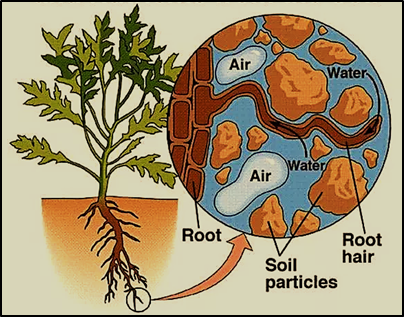
The form of water absorbed by the plant’s root system, from the soil is
A. Hygroscopic water
B. Gravitational water
C. Capillary water
D. All the above
Answer
497.7k+ views
Hint: Water from the soil is absorbed by the root systems or younger parts like root tips. In higher plants, the root system includes the root hairs that absorb water from the soil through osmosis. Plants take up water held in the soil against the gravitational force.
Complete answer:
Capillary water is the form of water absorbed from the soil via the root system of plants. Capillary water is the groundwater held in the capillary space formed between the soil particles. The water is held in these capillaries due to forces like the surface tension of soil particles and cohesion forces. It is also known as Growth water, which is available as films coated with small soil particles.
Figure 1: Water absorption from the soil by the plant root system

So, the correct answer is “Capillary water”.
Additional Information:
Other forms of water in soil include:
Hygroscopic water is the water tightly held at the soil surface by the cohesive and adhesive forces of soil particles. These forces reduce the water potential and hence hygroscopic water is not available for plants.
Gravitational water is the water that enters the soil and passes through the spaces between the soil particles to reach the water table. It increases the groundwater level and is not available for plants until the plants have long deep penetrating roots.
Runaway water is the rainwater that flows over the soil surface and cannot be captured by either soil or the plants.
The chemically combined water is the water that combines with the chemicals (like iron, silicon, aluminum, etc) in soil and is not free to be utilized by the plants.
Note: The root system of plants absorbs water from the soil through simple osmosis without spending much energy and thus can take up water which is held loosely in the soil. Thus, the root hairs which are very thin structures can easily penetrate through the spaces between the soil particles in the soil capillaries. Also since root hairs have a larger surface area, when it comes in contact with the capillary water, the cell membrane allows efficient absorption of capillary water into the root.
Complete answer:
Capillary water is the form of water absorbed from the soil via the root system of plants. Capillary water is the groundwater held in the capillary space formed between the soil particles. The water is held in these capillaries due to forces like the surface tension of soil particles and cohesion forces. It is also known as Growth water, which is available as films coated with small soil particles.
Figure 1: Water absorption from the soil by the plant root system

So, the correct answer is “Capillary water”.
Additional Information:
Other forms of water in soil include:
Hygroscopic water is the water tightly held at the soil surface by the cohesive and adhesive forces of soil particles. These forces reduce the water potential and hence hygroscopic water is not available for plants.
Gravitational water is the water that enters the soil and passes through the spaces between the soil particles to reach the water table. It increases the groundwater level and is not available for plants until the plants have long deep penetrating roots.
Runaway water is the rainwater that flows over the soil surface and cannot be captured by either soil or the plants.
The chemically combined water is the water that combines with the chemicals (like iron, silicon, aluminum, etc) in soil and is not free to be utilized by the plants.
Note: The root system of plants absorbs water from the soil through simple osmosis without spending much energy and thus can take up water which is held loosely in the soil. Thus, the root hairs which are very thin structures can easily penetrate through the spaces between the soil particles in the soil capillaries. Also since root hairs have a larger surface area, when it comes in contact with the capillary water, the cell membrane allows efficient absorption of capillary water into the root.
Recently Updated Pages
Master Class 9 General Knowledge: Engaging Questions & Answers for Success

Master Class 9 English: Engaging Questions & Answers for Success

Master Class 9 Science: Engaging Questions & Answers for Success

Master Class 9 Social Science: Engaging Questions & Answers for Success

Master Class 9 Maths: Engaging Questions & Answers for Success

Class 9 Question and Answer - Your Ultimate Solutions Guide

Trending doubts
State and prove Bernoullis theorem class 11 physics CBSE

What are Quantum numbers Explain the quantum number class 11 chemistry CBSE

Write the differences between monocot plants and dicot class 11 biology CBSE

Who built the Grand Trunk Road AChandragupta Maurya class 11 social science CBSE

1 ton equals to A 100 kg B 1000 kg C 10 kg D 10000 class 11 physics CBSE

State the laws of reflection of light




